You may have seen this video on YouTube – it got a bit of buzz when it came out a few months ago:
Well, Arsenal (no relation to Arsenal Bulgaria/Arsenal USA of AK fame) has an enormous banner at SHOT this year, and they have both the “Second Century” Siamese 1911 and their “Strike One” polymer service pistol on display. I decided to go take a closer look, expecting a novelty twin gun, a Glock clone, and a joke of a company. But there’s more to this company than what I expected…
The Siamese 1911: I still don’t know what to make of it. I’m sure a few will sell, because a few of just about anything will sell to someone. But I can’t for the life of me figure out who the target market is (at, BTW, a retail price somewhere in the $3000-$4000 range). For the record, apparently ATF approved it as a semiauto because the two shots (you can only fire pairs; the double slide is a single unit and you can’t operate either side of the gun independently) are fired simultaneously, not sequentially. Hey, they’re ATF and they can change rules when they feel like it. It’s a massive pistol, not very comfortable in the hand, and the grip safety feels awkward to engage. I also have some concern about what happens if you get a hangfire, and a round detonates partway through extraction. That all being said, I’m going to do my utmost to get a review sample of it to take to the range. They are apparently being manufactured by Tanfoglio, and the ones here at the show seemed very well made.
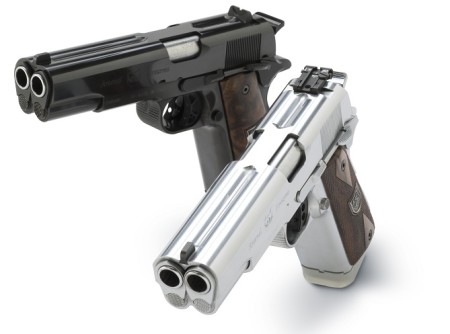
The Strike One: It doesn’t use a Browning tilting lock like (basically) every other major service pistol, it uses a dropping block and short recoil system. Seems clever, and it allows the bore to be noticeably lower than most other guns of this type. Other than that, it’s a striker-fired polymer service pistol. I think they will get plenty of interest in it, and we can wait and see what conclusion the market comes to. BTW, they said it would be $600-$700; competitive with Glock. Dunno which of those two possibilities they really meant, because a basic Glock is more like $500 in my neck of the woods.
Now the part that really got my attention and made me give this company a serious look. It turns out the company is a joint venture with a Russian named Dimitry Streshinskiy, who builds and extensive variety of gorgeous fully-functional miniature replica firearms. To succeed in that business, you really need to have the utmost attention to detail and craftsmanship, and while I don’t know much about Streshinskiy, his web site has a whole lot of pictures like this:
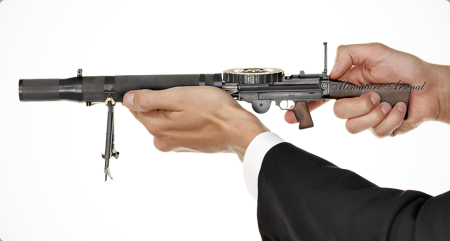
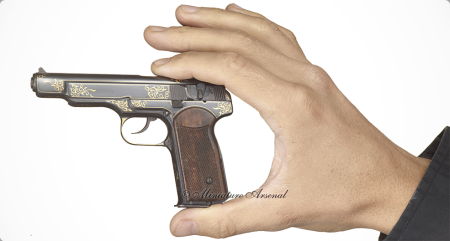
I’ll pay attention to any company being run by a guy who does work like that – it’s a good lesson in not writing something off without giving it a closer look first. I still can’t figure out the point of the Siamese 1911, but now I’m really curious.

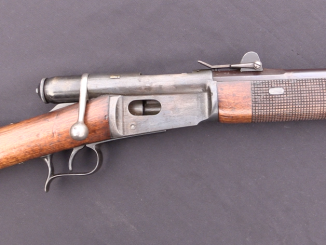
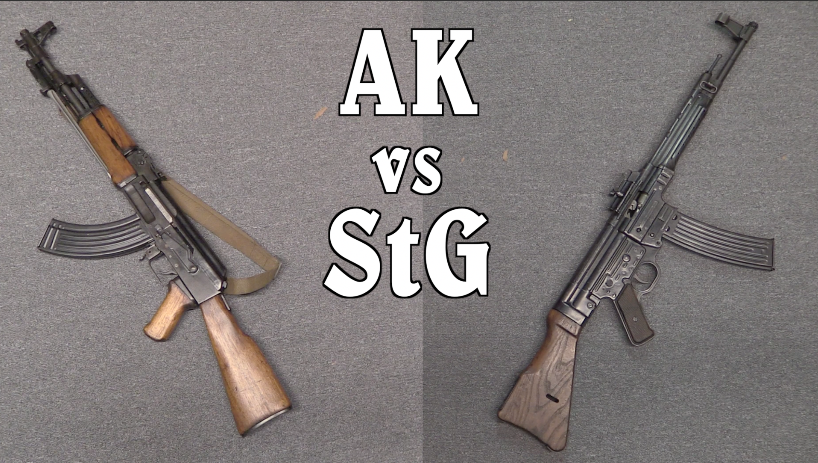

I’ll bite. How did thay avoid calling it the “Double Tap”?
1911 is completely useless ! Only rich man may buy that kind of gun just to show it to his friends – like “what a cool double handgun i got” …
STRIKE ONE is interesting, but lets wait till it comes to serial production. So much pistols were already named “Glock Killers” and Glock is still the best service pistol.
The film clip looks like a promo for a Bond film. I won’t be at all surprised if the pistol ends up in a future Bond film (the guy doing the demo would also make a great villain). I expect the “shoot ’em up” video game makers to use it as well.
It is obviously intended as a novelty item, and will sell in limited quantities to people who want to attract attention at the pistol range or to film makers. For the manufacturer, it’s a good way to draw attention to their other products and as such could be considered as a form of self-financing publicity stunt. As a service pistol (military or police) it’s obviously pointless.
As for the “Strike One”, I read about it on the “Modern Firearms” “guns.ru” web site (which my web browser is apparently telling me has a security compromise at the moment), and it sounds like something that is intended to address the same market as the Glock. The actual price will no doubt depend more on mark-up in the distribution channel than on actual design and manufacturing cost.
Firearms distribution can be a rather odd business, with some distributors deciding that they would rather make a large mark-up on a small quantity than a small mark-up on a large quantity. If you want to sell a *lot* of a new design to the civilian market, then you need to invest in sales channels, service, promotion, etc. Sales to military markets let you sell large quantities to a few customers, but the bidding process can be slow, and trials and approval also take time and money.
So, there can be a lot of reasons for the success or failure of a firearm beyond just its design.
In fact, when I asked to get a sample to review, one of the things I was told was that the one sample gun currently through importation is being used in a film in a couple weeks. 🙂
I wholeheartedly agree. Ian’s reply appears to confirm your assertions, to say the least.
To me, the AF2011 is merely meant to showcase their mad machinist skills.
Good observation — Now, if those same machining skills were to be applied to something more practical and battlefield user-friendly…..
It’s already done, or, at least, being applied in the Strike One / Strizh pistol.
I’ve been following Dimitry Streshinskiy’s work for awhile, and I must say that his work in functional miniature firearms is exquisite, to say the least.
yes it is
I’ve been able to handle a few of his miniature guns and talk to his crew who build them… These are 100% exact copies, with ALL parts funcioning exactly like prototype, with actual rifling in the barrels and 100% accurate reticles in working telescope sights where appropriate
Not surprisingly, prices for these little gems start from about 15,000 Eur (over $20,000) and only sky is the limit
Whew — at those prices, it’ll be less expensive for me to stick to purchasing the actual full-sized guns :)! Still, Mr. Streshinskiy’s art is both unique and definitely collectible.
The only pistol thats would actualy interest me is a Metall Storm defance,it have a 4 barrel but however pistol fires special ammunition,main operating part is a barrels and electrical discharge and thanks to its smart chip it can fire semi or rapid fire..
The Metall Storm pistol enhouses cigar like style ammo which separately have about 8 rounds in each stick,every single round fires by electrical charge send into indevidual round,in this particular technology magazine not recquired…
About double sided Colt 1911 is entirely stupid idea,just a waste of money but iam apologised for my criticizm still however this model doesnt feature anything new…
Did Metal Storm ever make that thing? A quick search didn’t turn up anything but some CG renderings. I think the company stopped stock trading 6 months ago. Wikipedia (yeah, I know, but I thought I’d check anyway) has an article that reads like a company press release. Even that only mentions actually shipping a few training versions of their electrically fired shotgun.
Can’t say I was ever a big fan of their superposed load (a 16th century technology, updated for electrical ignition). I’m no expert, but it looks to me like everyone that tried it had accuracy problems due to projectile deformation.
But if you like high volume output, bizarre guns… Anyone know what became of the “DREAD” centrifugal gun (http://www.defensereview.com/world-exclusive-video-dread-weapon-system-devastating-jam-proof-and-silent/) from a few years ago? A friend brought that one to my attention a few times. I saw… “issues” with the descriptions: “Imagine a gun with no recoil, no sound, no heat, no gunpowder, no visible firing signature (muzzle flash), and no stoppages or jams of any kind. Now imagine that this gun could fire .308 caliber and .50 caliber metal projectiles accurately at up to 8,000 fps (feet-per-second), featured an infinitely variable/programmable cyclic rate-of-fire (as high as 120,000 rounds-per-minute)…” Supersonic velocity, but silent? No recoil? Defense Review should have known better. The golf ball projectiles were amusing: http://www.defensereview.com/dad/DREAD%20Ball%20Ammo_Trinamic%20Technologies,%20LLC.jpg . (And it was tried in the 19th century: http://strangengines.wordpress.com/category/centrifugal-guns/ .)
Bear,
you just reminded me of something similar
http://www.crackingideas.com/news/wp-content/uploads/2011/04/soccamatic.jpg
Heh. I need to break out my Wallace & Gromit DVD again. [grin]
All I need to know about them is in the photo of that double 1911. I don’t care if it works or anything else. That’s just too stupid for words and anyone who would do it as more than a one off funzie thing (say the 1903 styled .45 ACP) needs to be slapped and then ignored. Along with anyone who would buy such garbage.
Sorry but it really hits my “What an ignorant SOB” button.
It would be interesting to pursue this new thread covering electric primer ignition in small arms. We all know that it has been used very successfully in machine guns, automatic cannon and larger weapons, but the application of the same technology to small, portable hand-held guns is potentially fascinating.
well, several years ago Reminton tried to sell electrically primed rifle ammo and appropriately modified Model 700 rifles under “EtronX” trade mark… Fail.
Thanks, Max! Now that you mention it, I seem to recall reading a bit about it somewhere. To your knowledge, do any other manufacturers, especially those from Eastern (including Russia) and Western Europe as well as Asia and Latin America plan on trying this, perhaps on a larger scale? There seems to be a great deal of ongoing innovation in those regions nowadays, which is why I am asking.
In the early eighties Heckler & Koch as well as another German manufacturer presented hunting rifles on the IWA show with electrical ignition. Both prototypes disappeared rather soon.
What advantage do you expect from electrical ignition?
Good point. I’m guessing H & K were probably a little too far ahead of market timing with this, plus taking into account the cost factor.
Electrically-primed ammunition does have certain advantages over conventional priming, i.e., fewer moving parts accompanied by greater maechanical simplicity on the part of the weapon firing such ammunition, and more precise timing of the firing sequence ( at a micro-second level ), together with potentially more reliable ignition. Of course, the trade-offs involve the complications of having to have a reliable external power source and the weight and logistical issues associated with that power source, which is why electrical priming has been largely confined to larger applications in aircraft, naval and ground-based applications where this is less of an issue.
However, what we’re looking at here, at least in design form, is the possible incorporation of state-of-the-art micro-electronics technology with ultra-low power consumption that might enable electric priming to become a viable and practical lightweight small-arms alternative in the future.
Although it is slower in coming to the firearms industry as a whole, the technical leaps and bounds afforded by electronics and electrical technology has already impacted every aspect of our lives in an almost unalterable fashion. One example : Compare the mobile phone / i-phone of today with the one you had just five years ago — no comparison. Same with computing devices of any kind, iPads included. Same again with the humble tactiacl flashlight — a few years ago, the xenon-halogen bulb was the way to go in high-intensity, energy-efficient flashlights, yet today these have been largely supplanted by cooler-running, longer-life, multi-function microprecessor-controlled lights that are much more energy-efficient and powerful at equivalent of lesser cost. There are in existence many Mil-Spec applications for the same in terms of aiming devices ( scopes, NVD’s, lasers, etc. ), so why not ammunition priming?
I am not saying that there is anything wrong with good, old-fashioned mechanical priming — being a little conservative myself, I have always liked the solidity and known reliability of mechanical priming in my firearms, but I think we should keep an open mind to what could become an important wave of the future.
I understand that one of the advantages of H&K’s electrical system was specific to caseless ammo applications. It let them use a high ignition temperature propellant that didn’t suffer from the chamber heat cook-off problem.
Regarding the Remington system… They hyped a 99% reduction in lock time over percussion ignition (http://www.popularmechanics.com/outdoors/survival/gear/1277311).
Slight correction to my previous post : In Paragragh 4, please read “Same again with the humble tactical flashlight — a few years ago, the xenon-halogen bulb was the way to go in high-intensity, energy-efficient flashlights, yet today these have been largely supplanted by cooler-running, longer-life, impact and vibration-resistant multi-function microprocessor-controlled LED lights that are much more energy-efficient and powerful at equivalent or lesser cost”.
Multiple barrel firearms would be better off as assault rifles, smg’s, machine guns. But its a bit gash when it comes to pistols.
If anyone is seriously into this stuff, there is a list here.
http://en.wikipedia.org/wiki/List_of_multiple_barrel_firearms
I must be a little nuts because I would like one of those 2011s based on the Para Ordnance P14-45 frame. Now that would be a monster!
I was under the impression that the reason that the double-barrel 1911 is considered semi-auto by the ATF is that it has two triggers, one for each barrel.
The triggers are connected, as are the hammers. Pull either trigger and it fires both barrels – there’s no way to fire a single shot. If you get clever and only load one magazine, it will fire but will not cycle the action.
What I wonder about twin 1911 is, if the barrel regulation being made for a
certain distance.
Strike One was heavily discussed at “Firearm Blog” last year.
The pistol, of course carries innovation. Its locking system can be described
best as a “Shriked P38”, since constructed with a dropping lock piece as verticaly
slided instead of hinged. Its trigger work constructed in lateral plane istead of
common vertical is also a innovation creating a very short barrel axis to hand
distance but, with a full cocked single action, seems having the lack of “Drop
Safety” feature which is present on Glocks with plastic “Safety Ramp” and even in
“Semi Cocked” configuration.
a comment:
“Don’t judge a book by its cover” unless what’s that book
and keep the “don’ts” for yourself and not only for others